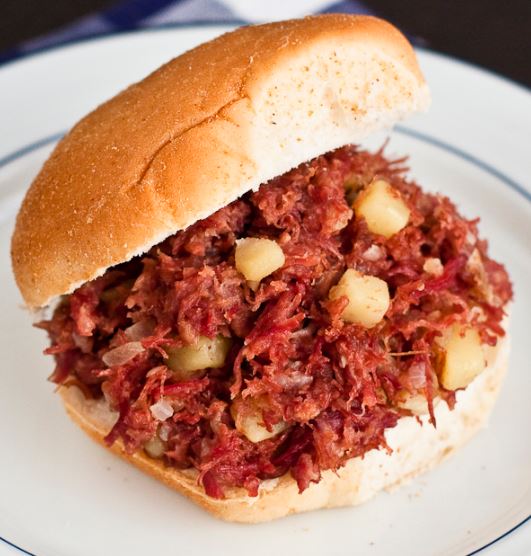I’ve always been skeptical about health warnings on canned foods, especially as I’m somewhat familiar with the canning process (which basically renders food bacteria-free). Now my suspicions have been justified by SCIENTISTS:
Microbiologist Richard Page, of Alliance Technical Laboratories, looked for a host of nasties, including the potentially deadly bacteria E.coli, salmonella, listeria and Clostridium perfringens, as well as for yeasts and moulds, which affect food quality but aren’t necessarily unsafe to eat.
Then food technologist Brian Smith, of Booth Smith Food Technology, analysed the results — and reached a very surprising conclusion.
…
There’s a reason canning has been a popular way of preserving food for the best part of two centuries. Canned food is subjected to a very high heat process to kill bacteria, and once sealed the contents are effectively sterile.
Sterilisation means heating to very high temperatures, killing all microbes. In 1974, tins of food from the wreck of a U.S. steamboat that sank in 1865 were tested. There had been a deterioration in appearance and vitamin content, but scientists found they were safe to eat.
…
“All of the best before dates you are looking at would absolutely not be for bacterial risk. The reasoning behind them would be due to quality,’ says Richard Page. “It may be the manufacturer knows that after a certain period of time there is a certain degradation in the taste or the flavour, colour or smell.”
Or it might just be because they want to sell more pineapple chunks.
Meanwhile, Brian Smith says food manufacturers do give “quite a margin of error” when setting best before dates — in some cases as much as 50 per cent.
So while “use by” dates should always be adhered to, “best before” is more an indicator of quality than a health alarm bell.
I remember eating some of my Y2K canned goods nearly ten years later, and none — I mean not one — tasted any differently than if I’d bought them the same day. Ditto some of my SHTF Grab ‘N Go supplies, just a couple years back. Most of the warning dates are just in case some guy eats 30-year-old corned beef hash he found in Nana’s pantry, and keels over — but even then, while the fats in the food might have caused the taste to deteriorate, the health risk is close to zero.
Read the article for all the details. And now, if you’ll excuse me, I’m off to the kitchen to make me some food:

Nom nom nom…

I’ve eaten some low quality beef stew MRE’s (not milspec) during hurricane Wilma that looked pretty bad and were not tasty but were sustaining. I still have some of those, I think. These days, my SHTF supplies are Mountain House freeze dried foods (thirty year shelf life). Just add water and eat from the pouch. I like them better than the microwave foods I normally eat on a daily basis and will break one out when I don’t feel like saddling up to go to the supermarket.
Funny that I have been trying various canned hash brands. So far Hormel Mary Kitchen is the best. BUT, it still falls short of that lovely picture. Libbys was the worstest. Came out with texture like toothpaste. May I ask what you would recommend?
I have some short term stuff I got from MREStar, and longterm stored foods from Mountain House. The MREs are… not outstanding, but they taste well enough that I could eat them.
There are several entertaining MRE reviewers on Youtube, but Steve1989 in particular is amusing because he will taste-test MUCH older rations from around the globe.
My Uncle was in the army in the 1960’s to early ’70s. He used to get us cool Army stuff like C-rations and fatigues that were too big for us but we wore them anyway. The C-rations were great for kids who didn’t know better. But we forgot one in the back of the cupboard and found it 20+ years later. The two cans were not puffy or leaking, but the contents… the fruit cocktail (might have been just fruit in syrup) had turned into brown sludge and the entree stew had clearly gone over to the dark side.
Might be lowest cost contractor, don’t know. But I have no issue eating spam and many canned things that are 3-5 years past date, as long as they’re not tomato based. I’ve seen stories about the acids and the cans and the linings of the cans and terrible things that can happen…
I notice that nobody wants to test 10-year old canned clams.
As I understand it, back in the bad old days, these cans would explode if left on the grocer’s shelf too long due to the extraordinarily high bacterial content of the clams and the insufficient heat used to process them.
I wonder what the shelf life is today.
Most stories about canned food being unsafe to eat derive from the early days when tin cans were coated internally with lead prevent the can from corroding from the content, and were sealed with lead solder.
People relying on them for prolonged periods ended up with lead poisoning of the slow and painful kind, which is what killed off some long duration exploration voyages quite effectively.
Add incidents of bad quality control causing large batches of spoiled canned food to hit the market at times, and a general mistrust of anything “not natural” and “chemical” and you have fertile breeding grounds for all kind of misinformation, scares, and hoaxes.
Like my mother used to believe religiously that canned food didn’t contain any nutrients whatsoever, especially that all vitamins were destroyed by the canning process. A belief she never lost until the day she died.